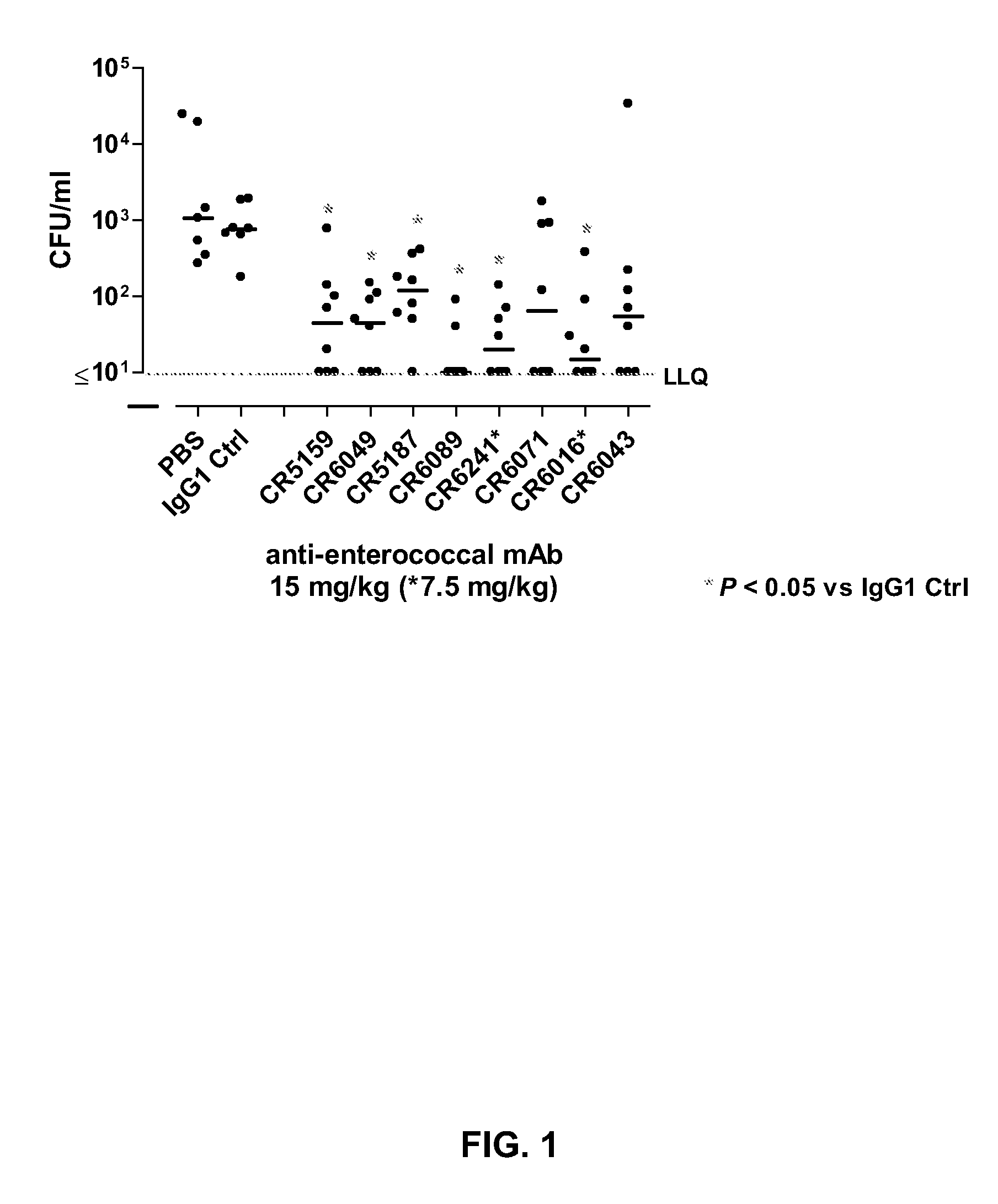Human binding molecules having killing activity against enterococci and uses thereof
a technology of human binding molecules and enterococci, which is applied in the field of medicine, can solve the problems of reducing the market interest of pharmaceutical companies, affecting the treatment effect, so as to prevent, cure or stop or inhibit the spread of enterococci, and reduce the cost of infection. the effect of $500 million
- Summary
- Abstract
- Description
- Claims
- Application Information
AI Technical Summary
Benefits of technology
Problems solved by technology
Method used
Image
Examples
example 1
Construction of scFv Phage Display Libraries Using RNA Extracted from Donors Screened for Opsonic Activity
[0109]Samples of blood were taken from donors reporting a recent gram-positive bacterial infection as well as healthy adults between 25-50 years of age. Peripheral blood leukocytes were isolated by centrifugation and the blood serum was saved and frozen at −80° C. Donor serum was screened for killing activity using an opsonophagocytic killing assay (Huebner et al. 1999) and compared to normal rabbit serum. Sera from donors having phagocytic activity greater than the normal serum were chosen to use for the generation of phage display libraries. Total RNA was prepared from the peripheral blood leukocytes of these donors using organic phase separation and subsequent ethanol precipitation. The obtained RNA was dissolved in RNAse free water and the concentration was determined by OD 260 nm measurement. Thereafter, the RNA was diluted to a concentration of 100 ng / μl. Next, 1 μg of RNA...
example 2
Construction of scFv Phage Display Libraries Using RNA Extracted from Memory B Cells
[0112]Peripheral blood was collected from normal healthy donors, convalescent donors or vaccinated donors by venapunction using EDTA anti-coagulation sample tubes. A blood sample (45 ml) was diluted twice with PBS and 30 ml aliquots were underlayed with 10 ml Ficoll-Hypaque (Pharmacia) and centrifuged at 900×g for 20 minutes at room temperature without breaks. The supernatant was removed carefully to just above the white layer containing the lymphocytic and thrombocytic fraction. Next, this layer was carefully removed (˜10 ml), transferred to a fresh 50 ml tube and washed three times with 40 ml PBS and spun at 400×g for 10 minutes at room temperature to remove thrombocytes. The obtained pellet containing lymphocytes was resuspended in RPMI medium containing 2% FBS and the cell number was determined by cell counting. Approximately 1×108 lymphocytes were stained for fluorescent cell sorting using CD24,...
example 3
Selection of Phages Carrying Single Chain Fv Fragments Specifically Binding to Enterococci
[0113]Antibody fragments were selected using antibody phage display libraries, general phage display technology and MAbstract® technology, essentially as described in U.S. Pat. No. 6,265,150 and in WO 98 / 15833 (both of which are incorporated by reference herein). The antibody phage libraries used were screened donor libraries prepared as described in Example 1 and IgM memory libraries prepared as described in Example 2. The methods and helper phages as described in WO 02 / 103012 (incorporated by reference herein) were used in the present invention. For identifying phage antibodies recognizing enterococci, phage selection experiments were performed using live bacteria in suspension or bacteria immobilized in immunotubes. The strains used are described in Table 8. All phage antibodies were isolated from selections wherein in at least one step E. faecalis 12030 in suspension was used. The phage ant...
PUM
| Property | Measurement | Unit |
|---|---|---|
| pH | aaaaa | aaaaa |
| concentration | aaaaa | aaaaa |
| volume | aaaaa | aaaaa |
Abstract
Description
Claims
Application Information
 Login to View More
Login to View More - R&D
- Intellectual Property
- Life Sciences
- Materials
- Tech Scout
- Unparalleled Data Quality
- Higher Quality Content
- 60% Fewer Hallucinations
Browse by: Latest US Patents, China's latest patents, Technical Efficacy Thesaurus, Application Domain, Technology Topic, Popular Technical Reports.
© 2025 PatSnap. All rights reserved.Legal|Privacy policy|Modern Slavery Act Transparency Statement|Sitemap|About US| Contact US: help@patsnap.com

